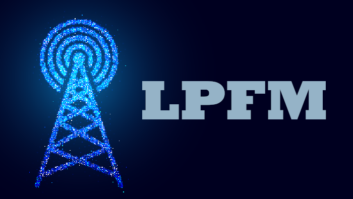Computerized planning and station engineering
Sep 1, 2001 12:00 PM, By John Battison, P.E., technical editor, RF
In the early days of radio engineering, it was necessary to calculate every value used in determining coverage and antenna design manually. Slide rules were the norm, and many engineers carried one in a hip holster � well, almost. My slide-rule case certainly had a belt slot in it.
This Dataworld map shows the area where a new FM transmitter can be located and still meet all FCC Rule requirements.

Today the computer and the calculator have replaced the slide rule. Forty years ago many engineers rented a Burroughs or similar machine to perform the iterations needed to design a directional AM antenna. It was left to Andy Ring, P.E., former FCC chief engineer and legendary consulting engineer, to develop and offer a calculating/computerized service. He named it Dataworld, and in addition to calculating services it offered a trustworthy database.
From the beginning
Over time, DataWorld’s offerings grew from simple AM directional antenna design calculations and a pattern book of all U.S. AM stations, to complete services in all branches of radio, TV and most RF work. I have found the DataWorld station database to generally be more accurate than the FCC’s database.
DataWorld’s CD database of all US stations includes pertinent station details. The data also extends into cell and wireless, and all microwave. The scope is worldwide, and topographic data is available on many countries.
Map bits
RadioSoft’s ComStudy 2.2 is a complete engineering package for performing AM, FM and TV propagation studies. Also included are groundwave, skywave 50%, skywave 10%, Region 2 skywave 50% and Region 2 skywave 10% contours. It will also perform ground conductivity studies.
The FM program is full featured for all types of FM studies including low power. Propagation models such as Longley-Rice, Bullington, Okumura and Epstein-Peterson are available. Contour capabilities include F (50,50), F (50,10) and Point-to-Point (PTP) service and interfering contours.
The program can also download the latest FCC license data and then assist the user in searching for possible new frequencies or locations by use of the frequency finder and allocation program. It will then rank these possibilities for the best possible chances of being available.
Lots of data
REALcoverage from CMBE offers several services. The type of station and the necessary technical parameters, such as location, height above ground, power, gain, losses and antenna patterns, are input into the system; all the stations of the network appear instantaneously on the map and are integrated in databases for further studies.
The system integrates several propagation models including FCC 98, Longley-Rice, Fresnel, Deygout 94, Okumura-Hata, ITU-R.P.370, ITU-R.P.525/526 and NBS 101, as well as several customized propagation models. The calculation incorporates free space propagation, diffraction, refraction and reflection. Physical interactions, like earth curvature, climate attenuation and ground occupancy linear attenuation are also considered.
Coverage is calculated for each point of the terrain and displayed on two-dimensional or three-dimensional maps. Composite and best server coverage, overlap and hand-over between stations, and other detailed studies are all available with automatic frequency assignment and optimum spectrum occupancy, re-using frequencies when possible to minimize interference.
Computer modeling, like this from RadioSoft, can make planning a site change much easier.

For microwave link projects, terrain profiles can be instantaneously extracted between two stations and complete path budget calculations generated for analog or digital stations.
This service uses internal databases that allow instant managing of as many sites as necessary. It can also integrate as standard the possibility to connect to external sources through an existing local or distant network (import and re-using of existing databases and share of technical information on a large scale).
Comprehensive link path analysis is standard within REALcoverage, showing a full and detailed cross section of the terrain and path geometry.
Running interference
V-Soft Communications offers allocation and coverage mapping for the AM standard band. Its maps will plot AM coverage signal contours and contour overlap based on the FCC AM rules. The maps apply the M3 or R2 ground conductivity curves, depending on which is needed. Using the same software developed for its long list of broadcast technical consultants and engineering clients, V-Soft Communications can provide custom mapping and engineering studies for just about every engineering purpose.
V-Soft maps can incorporate Longley-Rice, TIREM, Okamura/Hata/Davidson, Cost-231/Hata, PTP and the more common FCC standard contour method. The atlas-quality maps use advanced polygon shaping. V-Soft can produce representations of coverage from street level to statewide coverage. Multiple stations can be plotted on the same maps to show group coverage. Demographic information is included with each coverage map, and zip codes, FCC-registered towers and individual U.S. Census year 2000 centroids can be plotted on maps.
Other mapping options for the V-Soft client include incoming or outgoing interference studies. The studies automatically identify the stations to which interference is caused as well as those stations that cause interference to the client’s reference station facilities. Types of interference map studies include FM, TV and DTV. NCE to channel-six TV interference maps and analysis are also performed.
V-Soft Communications also gives you the option to make your own maps on your own computer because all of the software it uses to prepare its maps and studies is available for purchase.
A newer entry into the field of engineering software is rfEngineers.com. Its product, RfDetective-FM, helps FMs change class or power or locate frequencies for new FM stations. It also displays antenna height, location and channel of existing broadcasting stations. Four editions of rfDetective-FM are available. The Pro and Standard editions can create and modify jobs. The Pro edition can also create its own database directly from raw FCC data that can be downloaded from the FCC website. The Light edition can read and modify jobs created with the Pro or Standard editions, but cannot create a new job. A Reader edition is also available.


